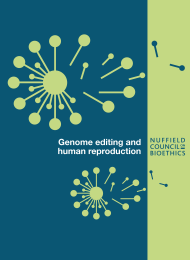Genome editing and human reproduction: social and ethical issues
Report
Published 17/07/2018

The potential role of genome editing in human reproduction
Genome editing has been heralded as a possible future option for people who are affected by or carriers of an inherited genetic disorder who wish to have a genetically related child but want to ensure that their child does not have the disorder.
Currently, genetic testing may be used to confirm whether a person is affected by, or a carrier of, a suspected genetic disorder. Prospective parents often know about the presence of an inherited genetic disorder in their family, in advance of any decision about becoming pregnant. This information might be known because either (or both) of them have the condition themselves, close family members have had it, or they already have one or more children with the condition.
If whole genome sequencing of people becomes more widespread it is likely that more genetic information that could be relevant to the health and welfare of future offspring will come to light, some of which could involve the interaction of a number of different genes.
What are the current reproductive options?
Currently, if couples carrying a genetic condition wish to ensure that a child they are hoping to have does not inherit that condition (or inherit a specific variant) , there are various options open to them. Not all of these options are available in all cases. There might be medical reasons to prefer one approach rather than another, although much may also depend on the preferences and expectations of the prospective parents.
If there is no overriding wish for the child to be genetically related to both parents, then these options might be considered:
- adoption; or
- sperm, egg, or embryo donation.
If there is a wish for a direct genetic link to both parents, then these options may be considered:
- Unassisted conception, followed by prenatal diagnosis to confirm the presence or absence of a genetic disease in the fetus. Termination of the pregnancy may be considered based on the diagnosis.
- IVF, incorporating preimplantation genetic diagnosis/testing (PGD/T). Early stage embryos are tested for indications of the genetic condition. One or more embryo(s) found to have the desired, or not to have the unwanted, characteristics can then be transferred to the womb.
- In rare cases in which an inherited genetic condition is transferred through the mitochondrial DNA, mitochondrial donation techniques may be an option. These techniques were the subject of a previous Nuffield Council on Bioethics report, and have recently been permitted for use as a treatment.
Where might genome editing come in?
Heritable genome editing interventions are not currently available as a reproductive option, but they could be in the future. The aim would be to edit a sequence of DNA in an embryo, sperm, or egg, in order to replace a variant of a gene that has one kind of effect with another known variant that has a different effect (for example, to replace a disease-causing variant with a non-disease variant). The edited DNA would then become part of the genome of the growing embryo so that any future person resulting from that embryo, sperm, or egg would have that variant in all their cells.
At present, we only know of a few, rare circumstances where genome editing would be the only option available for having a genetically related child while excluding a specific condition (i.e. where a given couple could not conceive a child who did not inherit that condition). These rare examples include:
- dominant genetic conditions, such as Huntington’s disease, where one of the prospective parents carries two copies of the disease-causing gene; and
- recessive genetic conditions such as cystic fibrosis or sickle cell anaemia where both of the prospective parents carry two copies of the disease-causing gene.
There are other cases, however, in which it is possible, but very difficult, to achieve the birth of a genetically related child with desired characteristics using alternative approaches, such as:
- where the aim is to exclude predispositions to complex disease;
- where there is a need to increase the number of available embryos with desired; characteristics (where selection following preimplantation testing would reduce the number significantly, making a live birth less likely); and
- where the aim is to select for multiple characteristics that are inherited independently (where it is less likely that an embryo with these would be found).
Beyond these circumstances, there is potential for genome editing to be used to influence a wider range of characteristics. If heritable genome editing proves to be a viable reproductive technology, it is possible that its repertoire of uses could expand. People may come to consider it as a reasonable alternative to existing selective techniques, and as a means to include variants in a way that selective techniques could not achieve.
It is possible that genome editing could be used in future for:
- building in resistance or immunity to a disease;
- increasing tolerance to environmental conditions; or
- enhancing senses or abilities.
Factors affecting the potential of heritable genome editing interventions to become widely used
There are big ‘ifs’ with genome editing in the context of human reproduction. Will it work? Will it be safe? How would it compare to other options? Who could afford it?
At this stage, we cannot confidently predict the extent to which the use of heritable genome editing interventions might spread if it were to be approved, the range of possible uses, or the potential for it to displace other selective technologies. The main influences on its potential as a technology are likely to include:
- the knowledge, skills, and resources needed to use it efficiently;
- public attitudes and opinions;
- investment in research; and
- the parallel development of other technologies and treatments (for example, therapeutic or preventative genome editing interventions for existing people – so-called ‘somatic gene therapies’).
Knowledge about the genome
The extent to which heritable genome editing interventions might become a part of assisted reproductive technologies will depend on developing our understanding of the genome (which contains the target sequence) and of the editing techniques themselves.
One of main reasons that it is hard to predict how useful genome editing will be is that we do not have a full understanding of how the genome functions. Although some single gene disorders are well-understood, most disease seems to be caused by the interaction of multiple genes, or of genes together with a variety of environmental factors. Many characteristics that differ between people, such as behaviour or intelligence, are more complex still. It is improbable that genome editing would offer a way to control these predictably.
The increasing availability and use of whole genome sequencing will enable the production of more knowledge about the genome but drawing insights from vast amounts of data will be a challenge. It remains to be discovered how closely many human characteristics can be associated with a particular genetic variant or combination of variants. Consequently, the range of potential uses of genome editing is hard to predict.
Public attitudes and opinions
Whether heritable genome editing interventions are used at all, and how their use might be expanded will also depend on public attitudes and opinions and prevailing social norms (the ways in which we expect people to behave in society). These may change over time, possibly as a result of the way the technology is introduced, taken up, or offered alongside existing assisted reproductive technologies. So that practice takes account of these norms, policies for the use of genome editing for any particular purpose should be informed by public interests that are identified and understood through broad and inclusive societal debate.

Share